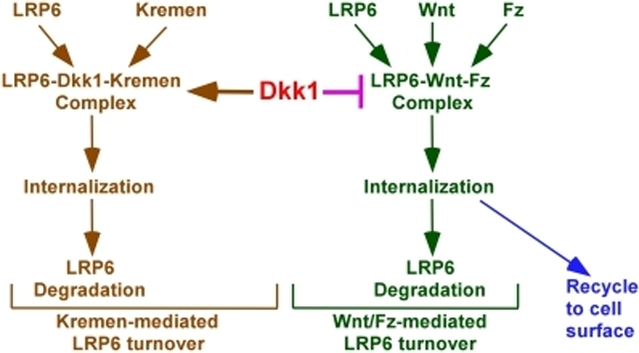
Memory
Memory Loss Associated With Alzheimer's May Be Reversible
Protein action at the synapse is implicated in Alzheimer's-related memory loss.
Posted September 28, 2016

Alzheimer’s disease routinely appears at or near the top of diseases most feared by Americans. It’s terrifying to contemplate and devastating when it happens. The memory loss that is a common symptom of Alzheimer’s begins with loss of function at the synaptic connections between neurons and progresses to the destruction of the neurons themselves. Research carried out by a team at University College London and recently reported in the journal Current Biology details how molecular changes at the synapse damage memory and suggests ways that the memory loss associated with Alzheimer’s may be prevented and possibly reversed.

The Wnt and Dkk1 proteins
A protein called Wnt plays an important role in a process called canonical Wnt signaling that is involved in the formation and development of synapses. Wynt signaling is also involved in modulating the communication between one neuron and the next that takes place at the synapse. Another type of protein called Dkk1 (Dickkopf-1) can block Wnt signaling by binding to the Wnt receptors on a neuron.
Prior research suggests that reductions in Wnt signaling and increases in Dkk1 are involved in Alzheimer’s. For example, the beta ameloid deposits that play a critical role in Alzheimer’s appear to increase production of Dkk1 in the brain, and post-mortem examinations of the brains of advanced Alzheimer’s patients show elevated levels of Dkk1. While these and other findings are suggestive, the effects on memory of the interplay between Wnt and Dkk1 at the synapse have not been fully examined.
The research team examined the effects of elevated levels of Dkk1 in the hippocampus (a structure in the brain that plays an important role in long-term memory) of specially bred mice. The mice were genetically engineered to increase secretion of Dkk1 when they are injected with the antibiotic doxycycline. Administration of doxycycline thus served as an on-off switch for producing elevated levels of Dkk1 in the hippocampus.
One group of specially bred mice (the Dkk1 mice) were given doxycycline injections for two weeks prior to testing while a group of their littermates (the control mice) were not. The researchers then carried out a variety of tests to determine how elevated levels of Dkk1 affected activity at the synapse and how blocking Wnt with Dkk1 affected long-term memory.
Examination of the effects of Dkk1 at the synapse showed that elevated levels of Dkk1 reduced the ability of a sending neuron to excite or activate a receiving neuron. Dkk1 also reduced the ability of two neurons to form stronger connections after recent co-activation (that is, Dkk1 reduced neural plasticity). In addition, the researchers were able to identify the specific metabolic pathways through which Dkk1 causes loss of function at the synapse.
Wnt, Dkk1 and memory loss
How blocking Wnt with Dkk1 affects memory was examined with water maze and conditioned fear tests. In a water maze test a mouse is placed in a circular tank of water that has a platform that is submerged just under the surface. The mouse has to swim until it finds the platform. Memory is measured in terms of how long it takes the mouse to swim back to the platform on later trials after it has found the platform on the first trial. The Dkk1 mice took significantly longer than the control mice to return to the platform on the third and fourth trials indicating that preventing Wnt from acting with Dkk1 disrupted spatial memory.
In the conditioned fear test, the mice were placed in an environment that was new to them and a shock was administered through an electrified grid in the floor. If the mouse remembers being shocked, it will be afraid the next time it’s placed in the same environment. When a mouse is afraid, it will freeze (cease all movement other than breathing). The length of time spent frozen is taken as a measure of the mouse’s memory for having been shocked the last time it was in the environment.
The mice in the experiment were put back in the environment where they had been shocked 24 hours after the shock had been administered. The control mice froze for roughly twice as long as the Dkk1 mice. This indicates that blocking Wnt activity with Dkk1 disrupts memory associations between locations and painful experiences that happened in those locations.
Taken together, the water maze and conditioned fear tests indicate that Wnt signaling plays an important role in the formation of memories and that blocking Wnt signaling with Dkk1 in the hippocampus can produce long-term memory deficits.
Can the loss of memory function be reversed?
Early-stage Alzheimer’s is typically diagnosed after synapses have been damaged but before there has been significant destruction of neurons. Can synaptic function be restored by eliminating the Dkk1 block on Wnt signaling or has Dkk1 blocking permanently damaged the synapses so that function is permanently lost?
The researchers addressed this question with new groups of Dkk1 and control mice. The Dkk1 mice were given doxycycline injections for two weeks to elevate levels of Dkk1 in the hippocampus. This was followed by two weeks without doxycycline to bring Dkk1 back to normal levels.
The Dkk1 and control mice were compared after the four-week, on-off Dkk1 period. The ability of sending neurons to excite receiving neurons was not significantly different between the two groups of mice. In other words, synaptic excitability was completely restored in the Dkk1 mice. The Dkk1 mice also exhibited full restoration of neural plasticity.
The mice were also given the conditioned fear test after the four-week, on-off period. Freezing time was the same for the Dkk1 mice and the controls. The long-term memory function that was lost when Wnt signaling was blocked by Dkk1 was restored when Dkk1 levels were reduced and Wnt was again able to function normally.
The restoration of long-term memory function combined with the restoration of excitation and neural plasticity at the synapse that was observed in these experiments indicates that the memory deficits that are symptomatic of Alzheimer’s disease may be reversible if the Dkk1 block on Wnt signaling can be removed before the destruction of neurons takes place.

This research provides hope for the future with regard to the treatment of Alzheimer’s disease. Identification of the interaction between Wnt and Dkk1 at the synapse focuses research aimed at developing treatments that prevent the spread of Alzheimer’s on finding ways to reduce excess Dkk1. Recent Alzheimer’s-related research shows one way this might be accomplished. Beta ameloid deposits appear to increase levels of Dkk1 in the brain and clinical trials have shown that the antibody aducanumab is effective in reducing beta ameloid deposits.
The finding that the loss of memory function caused by damage at the synapse can be reversed is especially encouraging. If Alzheimer’s can be caught early enough, not only might further spread be prevented but the loss of long-term memory function suffered by Alzheimer’s patients might be restored. The research reported in Current Biology is a long way from providing a treatment for Alzheimer’s disease but when combined with other recent advancements it may turn out to be a very important step toward the day when Alzheimer’s is no longer feared because it can be controlled.
A slightly different version of this article appeared on Forbes.com.



